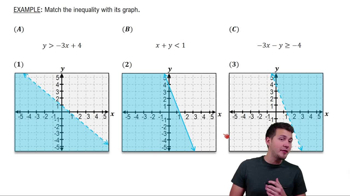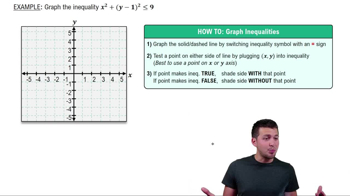Table of contents
- 0. Review of Algebra4h 16m
- 1. Equations & Inequalities3h 18m
- 2. Graphs of Equations43m
- 3. Functions2h 17m
- 4. Polynomial Functions1h 44m
- 5. Rational Functions1h 23m
- 6. Exponential & Logarithmic Functions2h 28m
- 7. Systems of Equations & Matrices4h 6m
- 8. Conic Sections2h 23m
- 9. Sequences, Series, & Induction1h 19m
- 10. Combinatorics & Probability1h 45m
7. Systems of Equations & Matrices
Graphing Systems of Inequalities
Problem 28
Textbook Question
Graph each inequality. y ≤ log(x - 1) - 2
 Verified step by step guidance
Verified step by step guidance1
Step 1: Identify the base function. The inequality involves the logarithmic function \( y = \log(x - 1) - 2 \). This is a transformation of the basic logarithmic function \( y = \log(x) \).
Step 2: Determine the transformations. The expression \( \log(x - 1) \) indicates a horizontal shift to the right by 1 unit, and the \(-2\) indicates a vertical shift downward by 2 units.
Step 3: Find the domain. The domain of \( \log(x - 1) \) is \( x > 1 \) because the argument of the logarithm must be positive.
Step 4: Graph the boundary line. Graph the line \( y = \log(x - 1) - 2 \) as a solid line because the inequality is \( \leq \), which includes the boundary.
Step 5: Shade the appropriate region. Since the inequality is \( y \leq \log(x - 1) - 2 \), shade the region below the line to represent all the points \( (x, y) \) that satisfy the inequality.
Recommended similar problem, with video answer:
 Verified Solution
Verified SolutionThis video solution was recommended by our tutors as helpful for the problem above
Video duration:
10mPlay a video:
Was this helpful?
Key Concepts
Here are the essential concepts you must grasp in order to answer the question correctly.
Inequalities
Inequalities are mathematical expressions that show the relationship between two values when they are not equal. They use symbols such as ≤ (less than or equal to), ≥ (greater than or equal to), < (less than), and > (greater than). Understanding how to interpret and graph inequalities is essential for visualizing the solution set of an inequality on a coordinate plane.
Recommended video:

Linear Inequalities
Logarithmic Functions
Logarithmic functions are the inverses of exponential functions and are defined as y = log_b(x) if and only if b^y = x, where b is the base. In the given inequality, log(x - 1) indicates a logarithmic function with a domain restriction (x > 1). Understanding the properties of logarithms, including their domain and range, is crucial for accurately graphing the inequality.
Recommended video:

Graphs of Logarithmic Functions
Graphing Techniques
Graphing techniques involve plotting points on a coordinate plane to represent equations or inequalities visually. For inequalities, the graph typically includes a boundary line (or curve) and shading to indicate the solution set. Knowing how to determine whether to use a solid or dashed line, as well as how to shade the appropriate region, is vital for correctly representing the solution to the inequality.
Recommended video:
Guided course

Graphs and Coordinates - Example

 7:2m
7:2mWatch next
Master Linear Inequalities with a bite sized video explanation from Patrick Ford
Start learning





